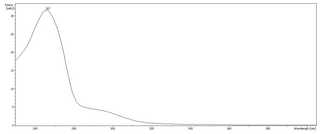
Phloroglucinol is an organic compound with the formula C6H3(OH)3. It is a colorless solid. It is used in the synthesis of pharmaceuticals and explosives. Phloroglucinol is one of three isomeric benzenetriols. The other two isomers are hydroxyquinol (1,2,4-benzenetriol) and pyrogallol (1,2,3-benzenetriol). Phloroglucinol, and its benzenetriol isomers, are still defined as "phenols" according to the IUPAC official nomenclature rules of chemical compounds. Many such monophenolics are often termed polyphenols.

Arame, sea oak is a species of kelp, of the brown algae, best known for its use in Japanese cuisine.
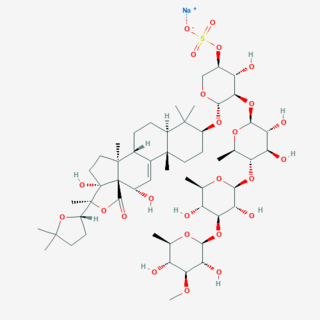
The holothurins are a group of toxins originally isolated from the sea cucumber Actinopyga agassizii. They are contained within clusters of sticky threads called Cuvierian tubules which are expelled from the sea cucumber as a mode of self-defence. The holothurins belong to the class of compounds known as saponins and are anionic surfactants which can cause red blood cells to rupture. The holothurins can be toxic to humans if ingested in high amounts.

Bulbocapnine is an alkaloid found in Corydalis and Dicentra, genera of the plant family Fumariaceae which have caused the fatal poisoning of sheep and cattle. It has been shown to act as an acetylcholinesterase inhibitor, and inhibits biosynthesis of dopamine via inhibition of the enzyme tyrosine hydroxylase. Like apomorphine, it is reported to be an inhibitor of amyloid beta protein (Aβ) fiber formation, whose presence is a hallmark of Alzheimer's disease (AD). Bulbocapnine is thus a potential therapeutic under the amyloid hypothesis. According to the Dorlands Medical Dictionary, it "inhibits the reflex and motor activities of striated muscle. It has been used in the treatment of muscular tremors and vestibular nystagmus".
Eisenia arborea, or the southern sea palm, is a dominant species of kelp that is found on the western Pacific coast of North America, from Vancouver Island, Canada south to Mexico's Isla Magdalena and Baja California, as well as in Japan. They are commonly found from the midtidal areas stretching to the subtidal areas. It is an edible seaweed, a source of nutrients for grazing marine invertebrates and a source of alginic acid, a food thickener. Some of the algas have a hollow stipe above its holdfast with two branches terminating in multiple blades. Eisenia arborea is studied in order to predict environmental stress in oceans intertidal zones. Hollow stipes where present when the Eisenia arborea did not receive essential nutrients for its thalli development. Eisenia arborea with hollow stripes are believed to be evolved algae in order to increase their survival in harsh living conditions. They play a huge role in determining environmental stress.
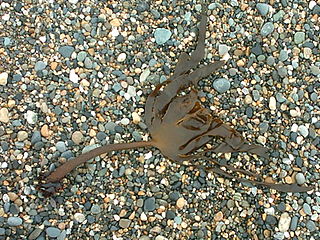
Ecklonia cava, is an edible marine brown alga species found in the ocean off Japan and Korea.

Ecklonia is a genus of kelp belonging to the family Lessoniaceae.
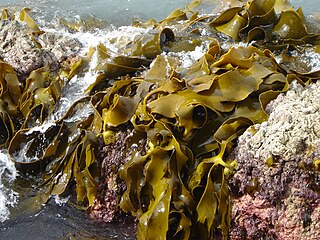
Phlorotannins are a type of tannins found in brown algae such as kelps and rockweeds or sargassacean species, and in a lower amount also in some red algae. Contrary to hydrolysable or condensed tannins, these compounds are oligomers of phloroglucinol (polyphloroglucinols). As they are called tannins, they have the ability to precipitate proteins. It has been noticed that some phlorotannins have the ability to oxidize and form covalent bonds with some proteins. In contrast, under similar experimental conditions three types of terrestrial tannins apparently did not form covalent complexes with proteins.
Croceitalea is a genus in the phylum Bacteroidota (Bacteria).

Phlorofucofuroeckol A is a phlorotannin isolated from brown algae species such as Eisenia bicyclis, Ecklonia cava, Ecklonia kurome or Ecklonia stolonifera.
Ecklonia stolonifera is a brown alga species in the genus Ecklonia found in the Sea of Japan. It is an edible species traditionally eaten in Japan.
Ecklonia kurome is a brown alga species in the genus Ecklonia found in the Sea of Japan.
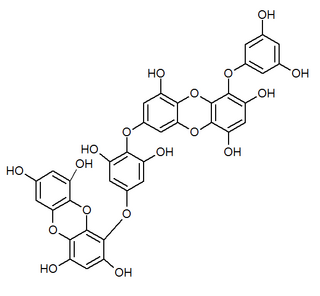
Dieckol is a phlorotannin that can be found in arame, in Ecklonia cava or in Ecklonia stolonifera.

8,8'-Bieckol is an eckol-type phlorotannin found in the brown algae Ecklonia cava and Ecklonia kurome.

6,6'-Bieckol is an eckol-type phlorotannin found in the brown algae Ecklonia cava and Ecklonia stolonifera.

Dryopteris crassirhizoma is a fern species in the wood fern family Dryopteridaceae.

Corydaline is an acetylcholinesterase inhibitor isolated from Corydalis yanhusuo.

Fucosterol is a sterol isolated from algae such as Ecklonia cava or Ecklonia stolonifera.
Winogradskyella eckloniae is a Gram-negative, aerobic, rod-shaped and motile bacterium from the genus Winogradskyella which has been isolated from the alga Ecklonia cava from the Jeju Island.













